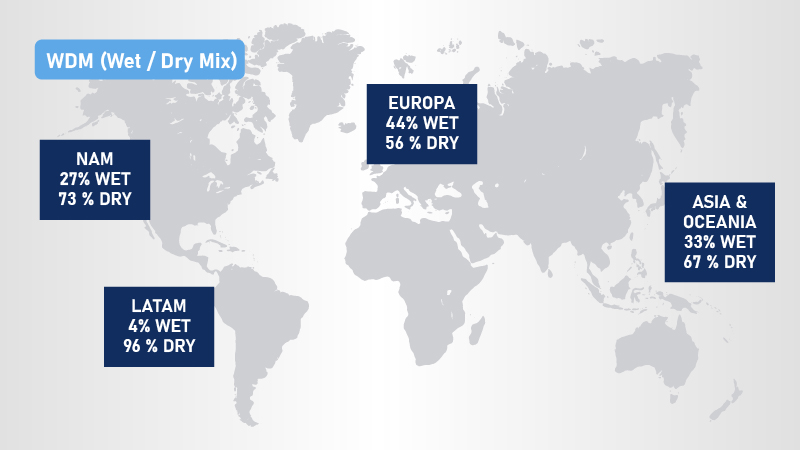This also implies changes in the pet market's trends.
These transformations that we are witnessing are the reason why wet foods have gained an important role in the market. The emergence of a new generation comes hand in hand with new demands and today, among them, we find the search for a good diet for dogs and cats based on the benefits of wet food.
Hence, these needs are directly reflected in the market numbers. In recent years, the sales of wet products have grown significantly. For example, in Europe, 44% of total food sales are dominated by wet foods, while 56% are dry foods. In the United States and Oceania, this type of food is also beginning to establish itself in the market, accounting for 27% and 33% of sales, respectively. Among those considered as wet, we find pâtés, mousses and other variants such as small pieces in sauce.

In Latin America, growth is still slow, but current behavior in the leading countries shows that this is a trend that will have a strong impact on the continent. If we look at the numbers, we can determine that it is a market dominated by dry foods, since the total percentage of sales is 90%. Wet products account for 7% and treats for 7%.
In any case, wet food is growing much faster than the other categories.

Growth in Argentina is also progressive, with total wet food sales representing 2%. This implies that there is still a long way to go, especially if we take into account that the appearance of wet products on the market in the region was only a few years ago. These emerged as complete foods for dogs and cats, as supplements for recovery after surgery, or as food for senior dogs or dogs with specific problems.
How can growth be accelerated?
All growth is based on development and innovation, i.e., new products are needed that are innovative and accelerate the growth of this category. Europe and North America are concrete proof that with improved products, the balance can be tipped towards the great benefits of wet foods.
Moreover, the pandemic had effects not only at the epidemiological level, but also on the socio-psychological aspects of people around the world. It is logical, then, that this has also had an impact on people's habits, behaviors and lifestyles: there are more families with dogs and cats, there has been a worldwide boom in adoptions, people are looking to expand their families and enjoy time at home surrounded by nature.
The increase in the population of dogs and cats implied, consequently, an increase in the market in general. There were also major changes in the way mass consumption products were purchased and wet foods were one of the categories with the higher increase in online sales.
Better and better, high quality and natural products are increasingly sought after. Wet foods are ideal for that. They are made with first quality products and ingredients, and this implies a balanced and complete nutrition. All these contextual changes have a direct impact on the market and it is essential for companies to be aware of them.
As we have seen, technologies are the source of very profound transformations, one of them being consumers. In a world surrounded by information and devices, a new generation of consumers called millennials is emerging.
It is the generation most committed to their pets, betting and investing more in them. Today, they are the largest owners of dogs and cats and the ones who spend the most money on veterinary preventive care and products.
In a survey conducted, 86% of millennial respondents feel that a natural food is vital for their pet. For them, it is essential that the food is produced with organic or natural and hypoallergenic materials. In this sense, wet is ideal for that.
The perception of pets has also changed with the emergence of this generation, causing consumers to demand the same values from brands that they will demand for other family members, including personalization, convenience and quality.
In the book 'Antrozoología y la relación humano-perro' (Anthrozoology and the human-dog relationship), Díaz Videla includes the results of a survey of his own made in Ciudad Autónoma de Buenos Aires, where he shows that:
In the event of an emergency where they must evacuate their home, 96% of participants said they would take their dog with them, even if it affected their own safety.
70% say that, faced with an extreme situation, if they had to choose between saving their dog's life or that of an unknown man, they would save their dog.
96.9% of Buenos Aires' residents consider their dog as a "member of their family" and 64% say it is "like a child".
Thus, changes in families imply changes in consumption habits, modes of purchase and even in the constitution of the family. Values change and certain ties and bonds are strengthened that were different in other times.
This is why companies must support these changes and adapt to the new needs of the market, which, although it is changing, it is always possible to analyze its trends.
By: WMG
You could be interested: Impulse Purchases Still Strong
Market Information
07/08/2025
The American Pet Products Association (APPA) Releases 2025 Dog & Cat Report, Revealing a New Era of Pet Ownership
29/07/2025























































